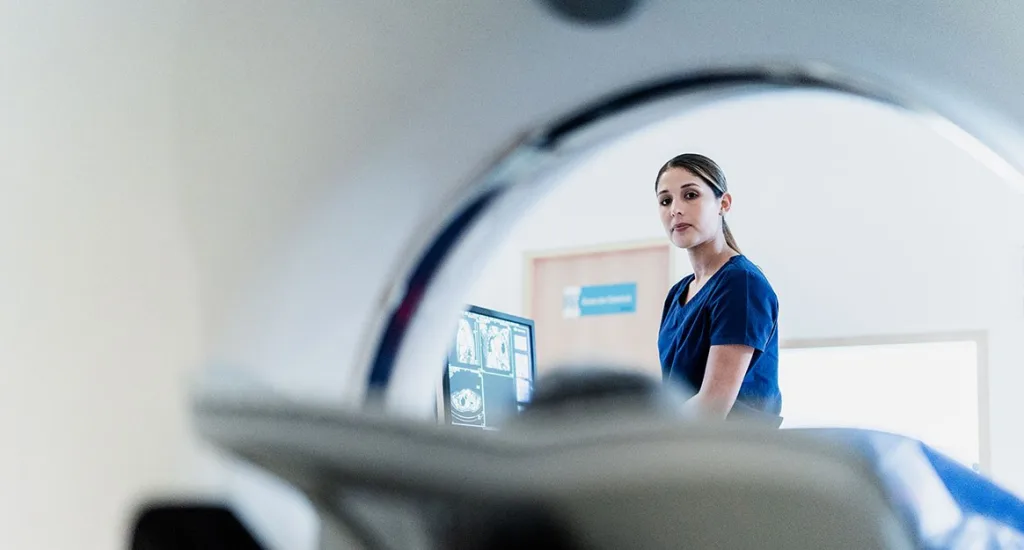Radiology nursing is rapidly evolving due to technology advancements and expanding roles. A radiology nurse must be skilled in use of AI tools, remote monitoring, and other patient-centered approaches.
Let’s cover key trends and innovations that are currently shaping the field of radiology nursing. Let’s explore how this dynamic role is evolving.
The rise of artificial intelligence in radiology
Artificial intelligence (AI) is being integrated into radiology workflows to enhance diagnostic accuracy, reduce workload, and improve patient outcomes. For a radiology nurse, this shift means adapting to new technologies and learning how to work alongside AI systems.
AI algorithms are increasingly being implemented in diagnostic radiology, to help radiologists interpret medical images like MRIs and CT scans. These systems can quickly examine large numbers of images, identifying patterns and anomalies that could be missed by a person. A radiology nurse must be familiar with AI tools and understand how to incorporate AI-generated data into patient care plans.
A radiology nurse can also use AI to prioritize cases based on the urgency of the findings. This ensures that patients with critical conditions receive prompt attention.
Radiology nurses are providing care remotely
The rise of teleradiology and remote monitoring has expanded the reach of radiology services, allowing nurses to care for patients across distances. For the radiology nurse, the ability to provide care remotely has introduced new opportunities.
Teleradiology involves the transmission of medical images from one location to another for interpretation by a radiologist. This trend has expanded access to imaging services, especially in rural or underserved locations. A radiology nurse coordinates the secure transmission of medical images and ensures timely communication between patients and radiologists.
More patients are receiving care remotely, including patients with chronic conditions who require ongoing monitoring. Wearable devices and remote monitoring technologies allow a radiology nurse to track their patient’s vital signs and health information in real-time, even if the patient isn’t physically present in the hospital.
New and increasing opportunities for radiology nurses
Demand for skilled radiology nurses is growing, driven by an aging population and the increasing complexity of diagnostic and interventional procedures. This landscape presents numerous career opportunities for a skilled radiology nurse.
Advanced practice roles
Radiology nurses are taking on new and specialized roles. For instance, a nurse practitioner in radiology performs advanced diagnostic procedures, such as image-guided biopsies. A clinical nurse specialist in radiology leads patient care initiatives, develops protocols, and educates staff.
These roles offer a higher level of autonomy, and also the potential for increased earnings and professional recognition. This allows a radiology nurse to take on more responsibility in patient assessment, diagnosis, and treatment planning.
Interventional radiology (IR)
This rapidly growing subspecialty uses imaging techniques (such as fluoroscopy, ultrasound, and CT scans) to guide minimally invasive procedures (such as biopsies, catheter placements, and stent insertion).
Radiology nurses in IR settings assist with procedures, monitor patients, and provide post-procedure care. Increasing demand for those IR services means more opportunities for radiology nurses to specialize in this area.
Leadership and management roles
As radiology departments become more complex, there’s a growing need for nurse leaders, managers, and educators. Radiology nurses in leadership roles are involved in staff training, policy development, and quality improvement initiatives.
A radiology nurse with leadership skills can move into roles such as Nurse Manager, Clinical Coordinator, or Director of Radiology Nursing. These positions involve supervising staff and managing department operations.
Leadership roles in radiology nursing offer the chance for career advancement. For a radiology nurse, it’s also an opportunity to positively influence patient care and nursing practice in the radiology department.
Innovations in patient care and safety
Patient care and safety are always at the forefront of radiology nursing. Recent innovations in the following areas are helping to enhance care quality and reduce any risks for patients undergoing radiological procedures:
- Radiation safety: One of the primary concerns in radiology is the safe use of ionizing radiation. Innovations such as dose optimization software allow for precise control of radiation levels during imaging techniques. Enhanced shielding techniques and real-time monitoring devices protect patients from unnecessary radiation.
- Patient-centered care: Virtual reality (VR) is being used to help patients visualize and understand procedures before they happen, reducing anxiety.
- Personalized imaging protocols: Diagnostic procedures are tailored to individual patient needs, considering factors like medical history, condition, and anatomy. For example, if a patient fears confined spaces, the radiology nurse could coordinate with the radiologist to shorten scan times. The radiology nurse could also schedule a pre-procedure visit to familiarize the patient with the equipment or employ distraction techniques (such as playing calming music).
- Enhanced communication tools: Mobile apps and patient portals allow for better pre- and post-procedure support. For instance, a radiology nurse might message a patient through an app before an MRI to explain what to expect and how to prepare. After the procedure, the radiology nurse might follow up with the patient via the portal to share results and answer questions.
- Emphasis on empathy and cultural competence: By understanding diverse patient backgrounds, a radiology nurse can better communicate. This builds trust and satisfaction during procedures. A radiology nurse might encounter a patient from a community that values modesty and prefers same-gender healthcare professionals, for example. The radiology nurse could arrange for a female technologist to perform a mammogram, ensuring the patient feels comfortable and respected.
- New infection control approaches: In radiology nursing, the risk of contamination is high due to frequent patient turnover and shared equipment. New disinfection technologies, such as UV-C light sterilization and antimicrobial coatings, reduce the risks of infection transmission. Automated cleaning systems for imaging machines and touchless protocols reduce the spread of pathogens. As a radiology nurse, you ensure that these technologies are used effectively and that all protocols are followed.
- Advanced electronic health records (EHRs): Enhanced interoperability features enable better communication across departments, lowering the risk of errors and improving patient outcomes. A radiology nurse can also analyze patient data to identify trends and track outcomes. This allows nurses to contribute to quality improvement initiatives, driving evidence-based care in radiology.
The future of radiology nursing education
The implementation of AI and other technology in nursing will transform education for radiology nurses. Here are a few ways radiology nursing education is changing:
- Simulation technology: Nurses in radiology can practice complex procedures (such as catheter insertions or emergency interventions) without risking patient safety. This type of training is particularly valuable in preparing nurses to work in high-stakes areas like IR.
- Online and hybrid learning: These programs make radiology nursing education accessible to a larger pool of students. For working nurses, it offers flexibility to further their education while continuing to work. Online courses cover theoretical knowledge, while in-person components focus on practical skills.
- Continuing education and certification, and specialty training: Radiology nurses can demonstrate advanced knowledge and skills by obtaining a Certified Radiology Nurse (CRN) credential through the Radiologic Nursing Certification Board (RNCB).
- Interdisciplinary education. There’s an emphasis on cross-training and collaborative education in health care. In the radiology field, nurses can participate in training programs alongside radiologists, technologists, and other healthcare professionals. For the radiology nurse, this fosters a deeper understanding of the roles and contributions of each team member.
Radiology nursing has a promising future
There’s a growing demand for radiology nurses, fueled in part by technological advancements. AI in imaging will enhance diagnostic accuracy, and the expansion of telemedicine continues to improve access for rural populations.
There’s also a focus on patient-centered care. At the same time, IR is opening up new roles. All of these factors contribute to a promising future for radiology nurses.
Looking forward, being a radiology nurse can expect a stable, rewarding career path. Additionally, radiology nurses have new opportunities for leadership, advanced roles, and the chance to influence innovative healthcare delivery.
Enter for a chance to win this month's Nurses Week 365 giveaway!








